Comparison: Nebulosity vs PixInsight
Posted: 16 September 2014
Part 2 - Nebulosity
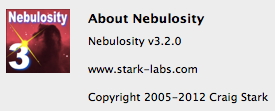 Nebulosity 3
Nebulosity 3
Stark Labs
$80 USD
Before I installed the software, I read the Nebulosity manual (PDF, 96 pages). I almost always read manuals before trying anything new. I also read "Processing DSLR Raw Deep-Sky Images with Nebulosity", which is somewhat out-of-date but still useful to provide an overview of the image processing steps.
A caveat: Nebulosity is both a "camera control" and an "image processing" application. It can control cameras of many makes and models. However, Nikon DSLR cameras are not currently supported for camera control. Since I do not (currently) plan to control my DSLR from a computer while at the telescope, I have no need for camera control and so that lack of Nikon support is not (currently) important to me. I will not be discussing the camera control functions in this review. If you need camera control, you should check the Nebulosity web site for the list of currently supported cameras. That page also lists the OS versions and computers supported. The application includes a "Camera Simulator" to see how Nebulosity can be used for camera control and you can try that in the demo version. Nebulosity supports "PHD Guiding", a popular free guiding package from Stark Labs. Nebulosity can edit images taken with a Nikon camera, both in Raw or JPEG formats.
Nebulosity supports the following image file formats: FITS, JPEG, BMP, TIFF, PNG, and TGA, in various image depths (16-bit, 24-bit, and 48-bit).
As I began working with the demo version of Nebulosity, I found it somewhat tiresome to be asked on each application launch for the license code and when no code was entered, to be told I was in demo mode:
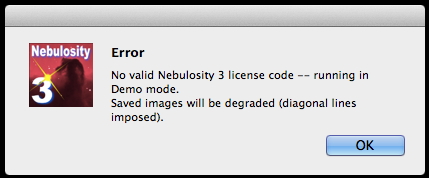
I've used other apps that just kept track of first launch in demo mode and then warned you when you were nearing the end of the demo time period. That is way less of a nuisance.
Nuisance aside, I did begin working with the application. This is the default window that opens:
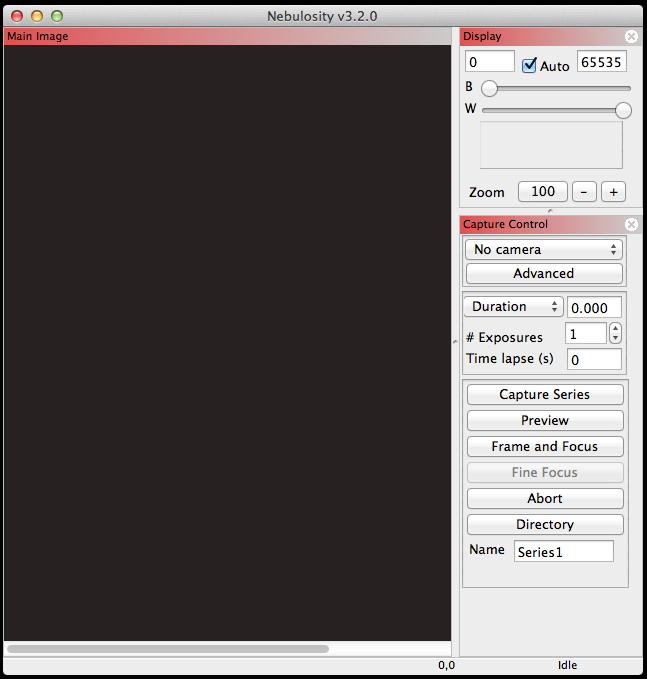
Nebulosity can be tailored to suit your needs and here you can see I removed the Camera Control options and added the History and Notes panes:
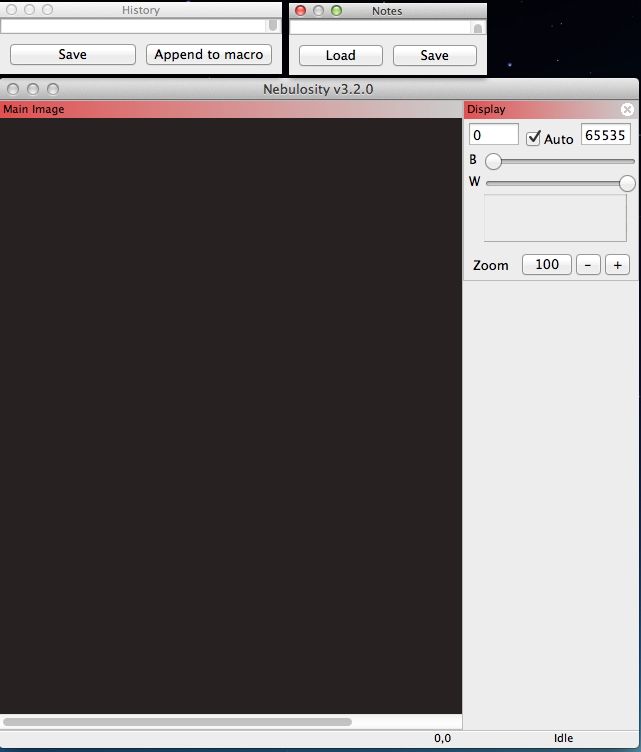
The next step was to tell Nebulosity which images I wanted to stack. Since I had no "darks" or "flats" at this point, I only had to select which type of alignment and stacking to do:
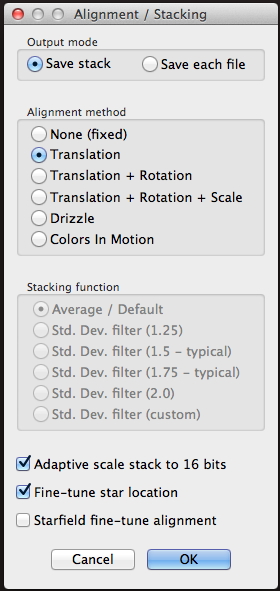
The two alignment methods most important to me are "Translation" and "Translation + Rotation". When I mount the DSLR on the telescope it is nearly impossible to get exactly the same orientation each night. So, if I were to do multi-night imaging of the same object, I would want to use the "Translation + Rotation" option. That option will ask you to identify two stars in each image so that the translation and rotation can be done. When using only "Translation" you pick only one star. For my two images of NGC660 that were taken on the same night without removing the camera between exposures, I selected "Translation". For my first use of the application I stayed with the "Average/Default" stacking function. I also left the other defaults selected as seen above. You then select the image files to stack. I selected the Nikon D7000 DSLR Raw NEF files to verify that Nebulosity could handle the Nikon Raw format. It did. If it had not, I would have used the TIFF files. I then selected the same star in each image. Stacking happened automatically after selecting the star in my last image and I was prompted to save the file, which was in FITS format. Next, I opened the FITS stacked image in Nebulosity:
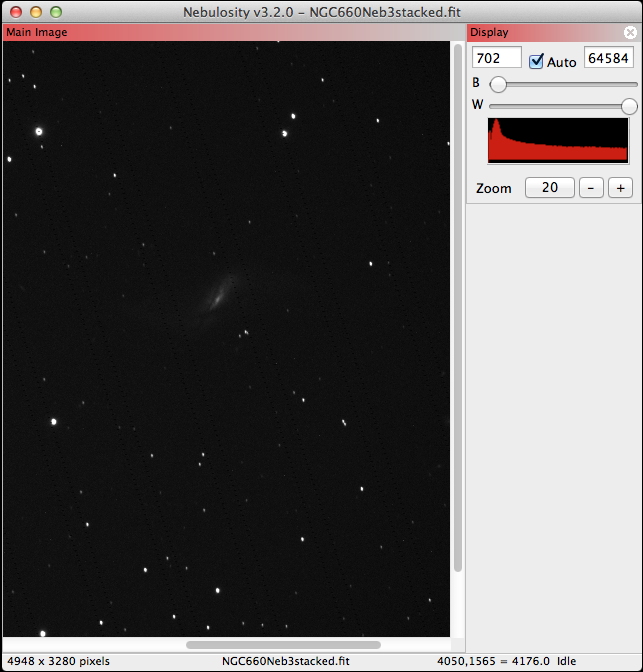
Now it was time to see what improvements I could make using the Nebulosity image processing tools available in the Image menu:
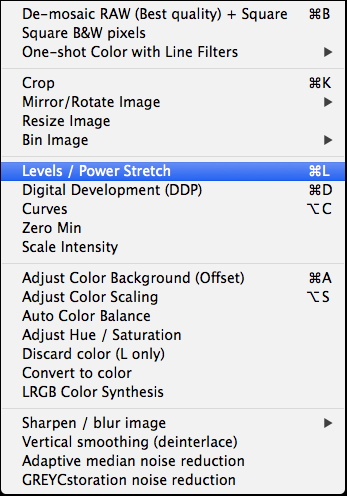
I cropped the image down to a manageable size, with just the galaxy and some stars showing. I then tried the "Levels/Power Stretch", which brings up a typical histogram and "levels" adjustment dialog:

As you move the sliders, the view of the changes you are making is not "live", but once you release the mouse button, the image updates to show your changes. Some other options in the Image menu are:
Digital Development (DDP)

Curves
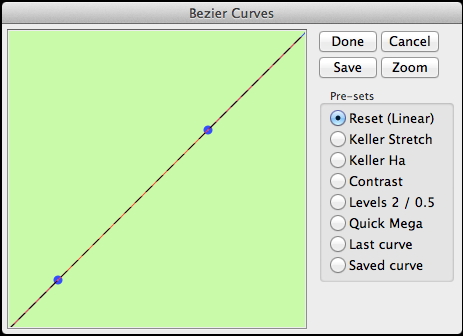
Scale Intensity

One capability I missed having in these dialog boxes was a "Reset" button to restore the values to their original state if I didn't like what I had done. Without a Reset button, it is necessary to Cancel and then reselect the option from the Image menu. You can also "Undo" any changes made but again, you have to re-open the dialog to began editing again. By the way, you can configure Nebulosity to have unlimited "Undo's"; the default is "3". I finally got to a point (with only 3 Undo's) where I was confused whether I had made any real edits to my image. Yes, I could have used the "History" window to check, but it was simpler to just close the window and re-open the FITS file. It was here that I discovered another slight nuisance with Nebulosity; instead of just closing the main window, the application also Quit, requiring a relaunch (and dealing with the nuisance demo alerts again).
After playing with the "levels" options, I finally decided to use the Curves function multiple times to stretch the image. That got me to this point:
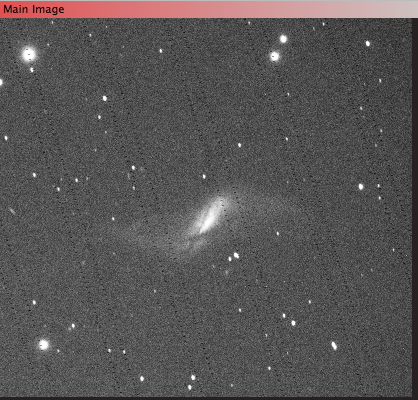
The black dots in diagonal lines in the image above are from the demo mode.
I tried the sharpening modes but didn't like any of the results. I did use the "Adaptive Median Noise Reduction" (75%) as that seemed to yield good results on this particular image. Again, a Reset button would have been a welcome feature here. I saved my edited image as a 16-bit color TIFF file. However, it actually was saved as a grayscale image. Somehow I had lost my color image. But the resulting image, edited in GraphicConverter and saved as JPEG (left) showed the "ring" better than the image I had previously stacked using Lynkeos (right):
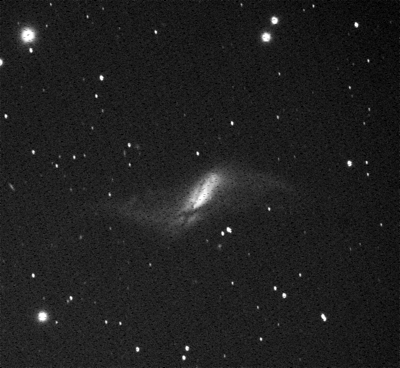

In looking back through the manual I could not find anything that explicitly stated how to retain the color. The NEF files were apparently immediately converted to grayscale when selected for stacking. So, I selected the original files that had been saved as TIFF; color was retained after the stacking. I again used Curves to edit the levels. The image had a severe red-ish cast, so I used the Color Scaling dialog to edit the colors (a Reset button would have been handy here too):
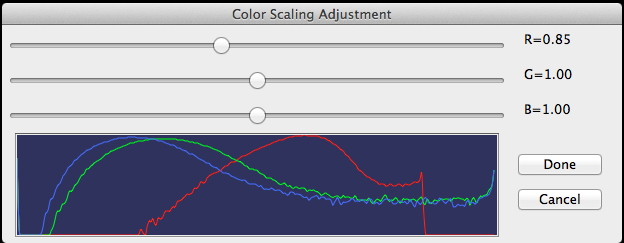
However, I discarded this version as I was able to edit out the red cast better in GraphicConverter. I did apply the same noise reduction in Nebulosity and saved the image as a 16-bit color TIFF file. The TIFF file was edited in GraphicConverter, with this result:
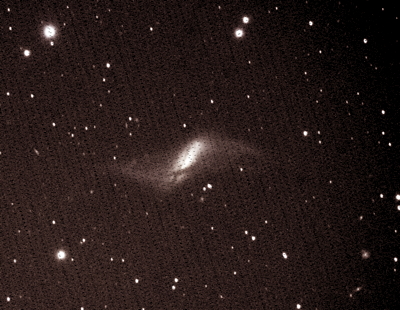
That's a fairly impressive image of a "Polar-Ring" Galaxy taken with an 8" telescope using a DSLR with only 20 minutes of exposure time, even with the demo-mode lines embedded.
Round 2 with Nebulosity
I did an imaging session on 14 September 2014 on the nebula NGC7023. Prior to the start of imaging and after the DSO imaging was completed I took a "dark" frame using the same exposure and ISO setting as I would use on the nebula by placing the aperture cover on the telescope. Would the "darks" improve the resulting stacked DSLR images? I did 30 1 minute, ISO 800, unguided exposures of NGC7023.
I edited one image using GraphicConverter. I adjusted the levels to bring out some of the nebula:
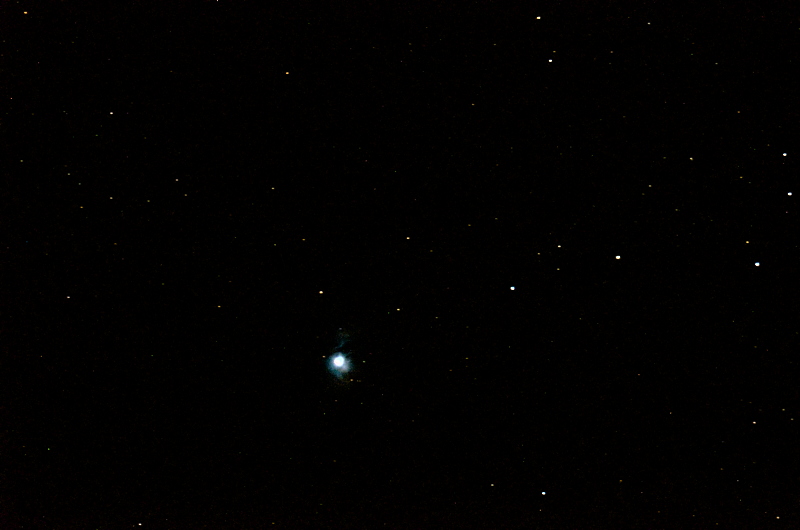
Not very impressive. A 2 minute, ISO 6400 exposure, taken on 17 September 2012, was much better:

But, what could Nebulosity do with 2 darks and 30 lights (of shorter exposures)?
First, I set up Nebulosity to pre-process the two dark frames and one light frame:
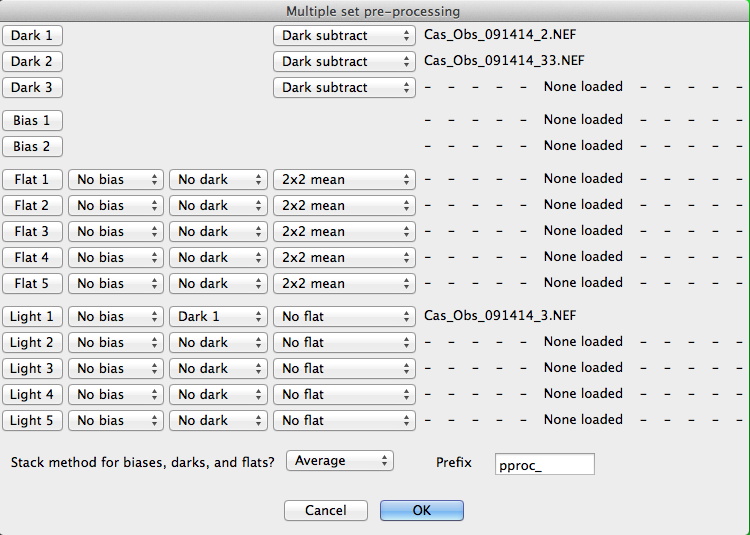
For my first stacking attempt I selected to have Nebulosity auto-select the alignment star. Unfortunately, several frames had an incorrect star selected. So I started over with the stacking and manually selected the alignment star in a few more frames and then Nebulosity figured out where the stars were in the remaining images and stacked all 30 frames correctly. But no nebula showed in the stacked image. Time for stretching. I tried Levels and Curves, but the best result was using the Digital Development (DDP) stretching:
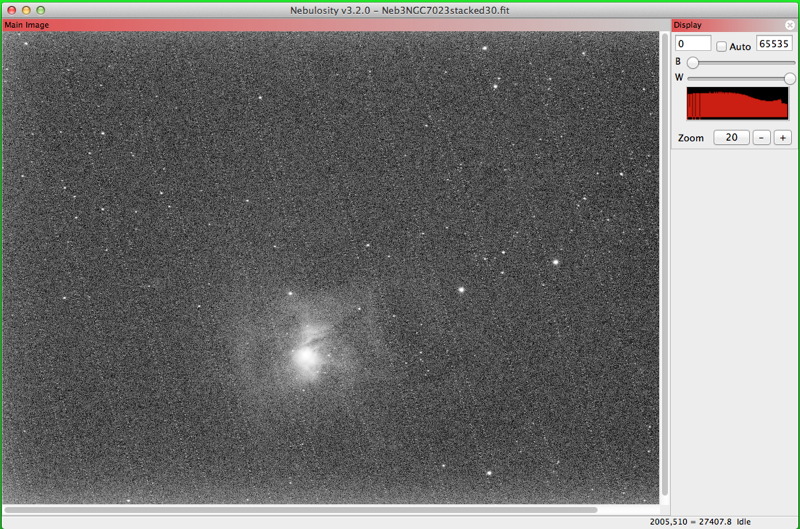
Next, I did the "Adaptive Median Noise Reduction" (75%), followed by a "Tighten Star Images". I saved the processed image as a JPEG and completed image processing using GraphicConverter. Cropped the image, then applied some levels adjustment and saved the image as a TIFF file. Processed the image using Neat Image to reduce digital noise even further, with this result:
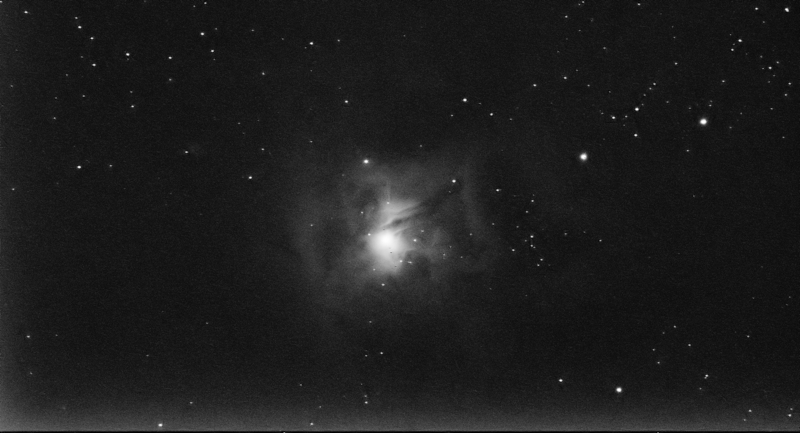
Wow, that's pretty impressive.
But oh yeah, it is black and white since I forgot to save the original Raw files as TIFF and use them in Nebulosity. Time for another processing run. This time I didn't use the dark frames to see if they made any significant difference. I stacked the 30 TIFF files. Then used DDP stretching but the result was horrible. Tried other levels adjustments in Nebulosity, but still could not get good results (in color). OK, lets try including the dark frames. Started over using the dark frames (saved as TIFF) and then stacked the 30 color TIFF image files. But still could not get good stretching. This was the best I could do:
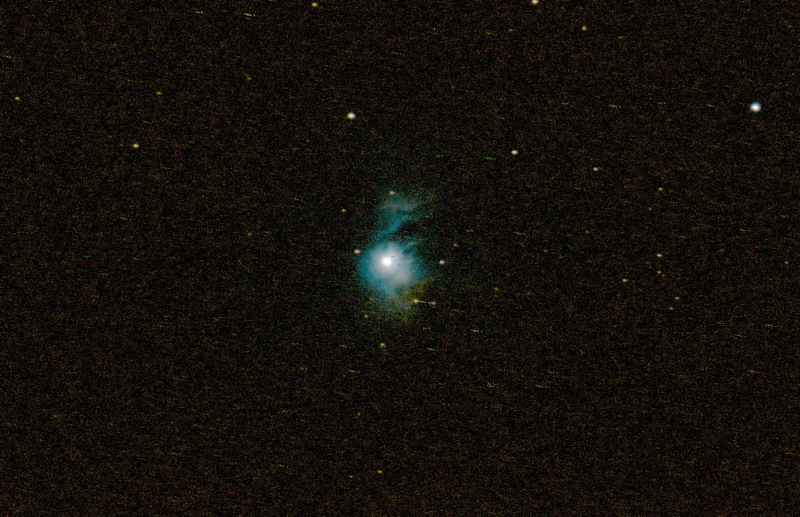
OK, one more thing to try. I adjusted the levels in Aperture to try to bring out the nebulosity. Unfortunately, the 1 minute, ISO 800 exposure did not capture the faint portions well enough. I would have needed longer exposures or higher ISO values. But longer exposures would have meant guiding would be required and higher ISO would have meant more noise, defeating the purpose of stacking shorter lower ISO images.
Comments are welcome using Email. If you are on Twitter you can use the button below to tweet this report to your followers. Thanks.
Cassiopeia Observatory Home Page
Copyright ©2014 Michael L. Weasner / mweasner@me.com
URL = http://www.weasner.com/co/Reviews/2014/Nebulosity_PixInsight/index2.html

